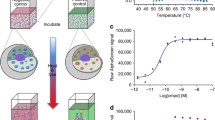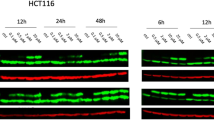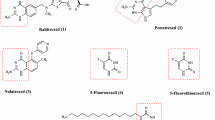Abstract
The TS-inhibitory effects induced by a 24-h exposure to the folate-based TS inhibitors CB3717, C2-desamino analogs of CB3717 including D1694, and BW1843U89 were quantitated using the MGH-U1 human bladder carcinoma. The effects of D1694 on the time course of TS inhibition and on intracellular deoxyuridine monophosphate (dUMP) accumulation and deoxyuridine (dUrd) production were evaluated. D1694 and BW1843U89 were the most active TS inhibitors with IC50 values of 2.4 and 0.5 nM, respectively. The C2-desamino C2-methyl dideazafolates were 27–292 times more potent than the parent CB3717 as TS inhibitors. A methyl group at the C2 position of CB3717 had the most dramatic effect, whereas a thiazole substitution for a benzyl added a small benefit and N10 substitution had a limited impact on TS-inhibitory potency and clonogenic survival. There was a significant correlation between the IC50 values for TS inhibition and those for cytotoxic potency obtained for these drugs. LV and thymidine protected cells from these folate-based TS inhibitors. Intracellular dUMP levels following 24 h D1694 (IC50) exposure increased 7-fold. Levels of dUrd effluxing into the media increased up to 4.5 μM following a 24-h exposure to D1694 (IC90). We conclude that (a) C2-desamino C2-methyl dideazafolates are potent TS inhibitors, (b) TS inhibition requires prolonged exposure with these folate TS inhibitors, (c) survival is correlated with inhibition of TS for the folate-based TS inhibitors and (d) the biochemical consequences of TS inhibition include increased dUMP and dUrd levels.
Similar content being viewed by others
Abbreviations
- TS:
-
thymidylate synthase
- D1694 :
-
N-{5-[N-(3,4-dihydro-2-methyl-4-oxoquinazolin-6-ylmethyl)-N-methylamino]-2-thenoyl}-L-glutamic acid
- BW1843U89 :
-
(S)-2-(5-[{1,2-dihydro-3-methyl-1-oxo-benzo(F)quinazolin-9-yl]-methyl}amino]1-oxo-2-isoindolinyl) glutamic acid
- CB3717 :
-
N 10-propargyl-5,8-dideazafolic acid
- dCB3717 :
-
2-desamino-N 10-propargyl-5,8-dideazafolic acid
- LV :
-
leucovorin
- FPGS :
-
folylpolyglutamate synthetase
- IC 50 :
-
IC 90 concentrations necessary to inhibit function by 50% and 90%, respectively
References
Rustum YM, Creaven PJ (1988) Symposium on the expanding role of folates and fluoropyrimidines in cancer chemotherapy. J Natl Cancer Inst 80: 1524–1525
Cantwell BM, Macaulay V, Harris AL, Kaye SB, Smith IE, Milsted RA, Calvert AH (1988) Phase II study of the antifolateN10-propargyl-5,8-dideazafolic acid (CB 3717) in advanced breast cancer. Eur J Cancer Clin Oncol 24: 733–736
Harding MJ, Cantwell BM, Milstead RA, Harris AL, Kaye SB (1988) Phase II study of the thymidylate synthetase inhibitor CB3717 (N10-propargyl-5,8-dideazafolic acid) in colorectal cancer. Br J Cancer 57: 628–629
Calvert AH, Newell DR, Jackman AL, Gumbrell LA, Sikora E, Grzelakowska-Sztabert B, Bishop JA, Judson IR, Harland SJ, Harrap KR (1987) Recent preclinical and clinical studies with the thymidylate synthase inhibitorN10-propargyl-5,8-dideazafolic acid (CB 3717). Natl Cancer Inst Monogr 5: 213–218
Bassendine MF, Curtin NJ, Loose H, Harris AL, James OF (1987) Induction of remission in hepatocellular carcinoma with a new thymidylate synthase inhibitor, CB3717. A phase II study. J Hepatol 4: 349–356
Calvert AH, Alison DL, Harland SJ, Robinson BA, Jackman AL, Jones TR, Newell DR, Siddik ZH, Wiltshaw E, McElwain TJ et al (1986) A phase I evaluation of the quinazoline antifolate thymidylate synthase inhibitor,N10-propargyl-5,8-dideazafolic acid, CB3717. J Clin Oncol 4: 1245–1252
Jackman AL, Taylor GA, Oconnor BM, Bishop JA, Moran RG, Calvert AH (1990) Activity of the thymidylate synthase inhibitor 2-desamino-N-10-propargyl-5,8-dideazafolic acid and related compounds in murine (L1210) and human (W1L2) systems in vitro and in L1210 in vivo. Cancer Res 50: 5212–5218
Jackman AL, Newell DR, Gibson W, Jodrell DI, Taylor GA, Bishop JA, Hughes LR, Calvert AH (1991) The biochemical pharmacology of the thymidylate synthase inhibitor, 2-desamino-2-methyl-N10-propargyl-5,8-dideazafolic acid (ICI 198583). Biochem Pharmacol 42: 1885–1895
Jackman AL, Taylor GA, Gibson W, Kimbell R, Brown M, Calvert AH, Judson IR, Hughes LR (1991) ICI D1694, a quinazoline antifolate thymidylate synthase inhibitor that is a potent inhibitor of L1210 tumor cell growth in vitro and in vivo: a new agent for clinical study. Cancer Res 51: 5579–5586
Duch DS, Banks S, Dev IK, Dickerson SH, Ferone R, Heath LS, Humphreys J, Knick V, Pendergast W, Singer S et al (1993) Biochemical and cellular pharmacology of 1843U89, a novel benzoquinazoline inhibitor of thymidylate synthase. Cancer Res 53: 810–818
Erlichman C, Vidgen D (1984) Cytotoxicity of Adriamycin in MGH-U1 cells grown as monolayer cultures, spheroids, and xenografts in immune-deprived mice. Cancer Res 44: 5369–5375
Aschele C, Romanini A, Nicolin A, Rosso R, Sobrero A (1990) Comparison of in vitro drug sensitivity by inhibition of tritium release from [5-3H]-2′-deoxyuridine and a clonogenic assay. Anticancer Res 10: 759–764
Yalowich JC, Kalman TI (1985) Rapid determination of thymidylate synthase activity and its inhibition in intact L1210 leukemia cells in vitro. Biochem Pharmacol 34: 2319–2324
Pressacco J, Erlichman C (1994) Combination studies with 3′-azido-3′-deoxythymidine (AZT) plus ICI D1694. Biochem Pharmacol (in press)
Grem JL, Mulcahy RT, Miller EM, Allegra CJ, Fischer PH (1989) Interaction of deoxyuridine with fluorouracil and dipyridamole in a human colon cancer cell line. Biochem Pharmacol 38: 51–59
Roberts D (1966) An isotopic assay for thymidylate synthetase. Biochemistry 5: 3546–3548
Frick LW, Nelson DJ, St Clair MH, Furman PA, Krenitsky TA (1988) Effects of 3′-azido-3′-deoxythymidine on the deoxynucleotide triphosphate pools of cultured human cells. Biochem Biophys Res Commun 154: 124–128
Erlichman C, Mitrovski B (1994) Comparative cytotoxicity of folate-based inhibitors of thymidylate synthase and 5-fluorouracil ±leucovorin in MGH-U1 cells. Cancer Chemother Pharmacol 34: 51–56
Marsham PR, Hughes LR, Jackman AL, Hayter AJ, Oldfield J, Wardleworth JM, Bishop JA, O'Connor BM, Calvert AH (1991) Quinazoline antifolate thymidylate synthase inhibitors: heterocyclic benzoyl ring modifications. J Med Chem 34: 1594–1605
Jones TR, Thornton TJ, Flinn A, Jackman AL, Newell DR, Calvert AH (1989) Quinazoline antifolates inhibiting thymidylate synthase: 2-desamino derivatives with enhanced solubility and potency. J Med Chem 32: 847–852
Jones TR, Betteridge RF, Neidle S, Jackman AL, Calvert AH (1989) Quinazoline antifolates inhibiting thymidylate synthase: computer modelling of the N10 substituent. Anticancer Drug Des 3: 243–248
Hughes LR, Jackman AL, Oldfield J, Smith RC, Burrows KD, Marsham PR, Bishop JA, Jones TR, O'Connor BM, Calvert AH (1990) Quinazoline antifolate thymidylate synthase inhibitors: alkyl, substituted alkyl, and aryl substituents in the C2 position. J Med Chem 33: 3060–3067
Pawelczak K, Jones TR, Kempny M, Jackman AL, Newell DR, Krzyzanowski L, Rzeszotarska B (1989) Quinazoline antifolates inhibiting thymidylate synthase: synthesis of four oligo(L-gammaglutamyl) conjugates ofN10-propargyl-5,8-dideazafolic acid and their enzyme inhibition. J Med Chem 32: 160–165
Jackman AL, Taylor GA, Moran RG, Bishop JAM, Bisset G, Pawelczak K, Balmanno K, Hughes LR, Calvert AH (1988) Biologic properties of 2-desamino-2-substituted-5,8-deazafolates that inhibit thymidylate synthase (TS) (abstract). Proc Am Assoc Cancer Res 29: 287
Jackman AL, Taylor GA, Calvert AH, Harrap KR (1984) Modulation of anti-metabolite effects: effects of thymidine on the efficacy of the quinazoline-based thymidylate synthetase inhibitor, CB3717. Biochem Pharmacol 33: 3269–3275
Berger SH, Hakala MT (1984) Relationship of dUMP and free FdUMP pools to inhibition of thymidylate synthase by 5-fluorouracil. Mol Pharmacol 25: 303–309
Curtin NJ, Harris AL (1988) Potentiation of quinazoline antifolate (CB3717) toxicity by dipyridamole in human lung carcinoma, A549, cells. Biochem Pharmacol 37: 2113–2120
Curtin NJ, Harris AL, Aherne GW (1991) Mechanism of cell death following thymidylate synthase inhibition: 2′-deoxyuridine-5′-triphosphate accumulation, DNA damage, and growth inhibition following exposure to CB3717 and dipyridamole. Cancer Res 51: 2346–2352
Author information
Authors and Affiliations
Additional information
This study was supported by a grant from the National Cancer Institute of Canada
Rights and permissions
About this article
Cite this article
Mitrovski, B., Pressacco, J., Mandelbaum, S. et al. Biochemical effects of folate-based inhibitors of thymidylate synthase in MGH-U1 cells. Cancer Chemother. Pharmacol. 35, 109–114 (1994). https://doi.org/10.1007/BF00686631
Received:
Accepted:
Issue Date:
DOI: https://doi.org/10.1007/BF00686631




